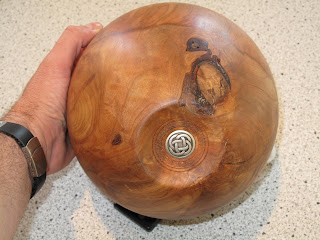
Recently an old college roommate, who also live in Seattle, mentioned he'd taken down one of my favorite trees in his backyard -- a very old curly willow. He'd remembered I had admired its gnarly features and wondered if I'd like a piece.
So, I went over with the kids in tow and had a look. The trunk was in pretty bad shape, but I thought why not?
 As you can see, the piece I ended up with was about rotten all the way through. So punky, it took over an hour to rough it out. (The fact that this is a very soft wood and pretty difficult to keep straight in a chuck in the first place didn't help much either...)
As you can see, the piece I ended up with was about rotten all the way through. So punky, it took over an hour to rough it out. (The fact that this is a very soft wood and pretty difficult to keep straight in a chuck in the first place didn't help much either...) So back to the original question: Why bother?
So back to the original question: Why bother?For a couple of reasons. First, I wonder how far a a piece of wood can be gone and you're still able to work with it. Second, there's no better teacher than experience, so go for it, and see what happens. Third, this is a piece from a friend, from a tree that has memories attached to it; maybe I can return it, along with some if it's memories. (For example, see that black hole? That's where he'd sunk a metal screw into the tree to hold a swing for his kids.
 As for the wood itself, Willow is very soft. The first time it's dropped, a dent will appear. But, there's beauty in the grain; as with all woods. And I aim to find it.
As for the wood itself, Willow is very soft. The first time it's dropped, a dent will appear. But, there's beauty in the grain; as with all woods. And I aim to find it. If I do manage to pull a bowl from this piece, it's most likely won't last very long. Then again, what does?




































